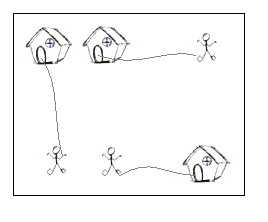| Time Limit: 1000MS | Memory Limit: 65536K | |
| Total Submissions: 22415 | Accepted: 11330 |
Description
On a grid map there are n little men and n houses. In each unit time, every little man can move one unit step, either horizontally, or vertically, to an adjacent point. For each little man, you need to pay a $1 travel fee for every step he moves, until he enters a house. The task is complicated with the restriction that each house can accommodate only one little man.Your task is to compute the minimum amount of money you need to pay in order to send these n little men into those n different houses. The input is a map of the scenario, a ‘.’ means an empty space, an ‘H’ represents a house on that point, and am ‘m’ indicates there is a little man on that point.

You can think of each point on the grid map as a quite large square, so it can hold n little men at the same time; also, it is okay if a little man steps on a grid with a house without entering that house.
Input
Output
Sample Input
2 2
.m
H.
5 5
HH..m
.....
.....
.....
mm..H
7 8
...H....
...H....
...H....
mmmHmmmm
...H....
...H....
...H....
0 0
Sample Output
2
10
28
题意
给出一张地图, . 是空地, H 是房子, m 是小人,并且地图上有相同数量的房子与小人,每个小人每次只能横向或者纵向移动一格,求最终所有人都找到一间独立的房子所走的步数。
思路
幸好地图上没有墙(降低难度),人物也可以相遇在同一格,那么小人距离任意一个房间的步数便是它们两者横坐标差+纵坐标差。
找一个源点,它与所有小人之见都有一条容量为1费用为0的边,然后所有房子与汇点之间也有一条容量为1费用为0的边,小人与房子之间的边容量为1,费用为它们之间的距离(步数)。
当然反向建图也可以,因为这张图是对称的嘛!并且房子个数与小人个数也相等。
然后求从源点到汇点之间的最小费用即可。
AC 代码
#include<iostream>
#include<algorithm>
#include<stdio.h>
#include<string.h>
#include<math.h>
#include<iostream>
using namespace std;
#include<queue>
#include<map>
const int MAXX = 10005;
const int INF = 0x3f3f3f3f;
struct edge
{
int to; //边终点
int next; //下一个兄弟位置
int cap; //容量
int flow; //流量
int cost; //费用
} edge[MAXX<<2];
int head[MAXX],tol;
int pre[MAXX],dis[MAXX];
int N; //节点总个数
void init(int n)
{
N=n;
tol=0;
memset(head,-1,sizeof(head));
}
void addedge(int u,int v,int cap,int cost) //同时增加原边与反向边
{
edge[tol].to=v;
edge[tol].cap=cap;
edge[tol].cost=cost;
edge[tol].flow=0;
edge[tol].next=head[u];
head[u]=tol++;
edge[tol].to=u;
edge[tol].cap=0;
edge[tol].cost=-cost;
edge[tol].flow=0;
edge[tol].next=head[v];
head[v]=tol++;
}
/*
* SPFA 算法判断是否存在s到t的通路
*/
bool spfa(int s,int t)
{
queue<int>q;
bool vis[MAXX];
for(int i=0; i<N; i++)
{
dis[i]=INF;
vis[i]=false;
pre[i]=-1;
}
dis[s]=0;
vis[s]=true;
q.push(s);
while(!q.empty())
{
int u=q.front();
q.pop();
vis[u]=false;
for(int i=head[u]; i!=-1; i=edge[i].next) //遍历所有与u临接的点
{
int v=edge[i].to;
if(edge[i].cap>edge[i].flow&&dis[v]>dis[u]+edge[i].cost) //如果可以松弛该点
{
dis[v]=dis[u]+edge[i].cost;
pre[v]=i;
if(!vis[v]) //如果该点不在队列中,入队
{
vis[v]=true;
q.push(v);
}
}
}
}
return (pre[t]!=-1); //返回是否s到t是否有路径
}
/*
* int s 起点
* int t 终点
*/
int minCostMaxFlow(int s,int t,int &cost)
{
int flow=0;
while(spfa(s,t))
{
int minn=INF; //当前路径可增广值
for(int i=pre[t]; i!=-1; i=pre[edge[i^1].to]) //因为建图时每增加一条边会同时加入它的反向边,因此i^1为找出与i刚好相反的部分
{
if(minn>edge[i].cap-edge[i].flow)
minn=edge[i].cap-edge[i].flow;
}
for(int i=pre[t]; i!=-1; i=pre[edge[i^1].to]) //修改图,计算花费
{
edge[i].flow+=minn;
edge[i^1].flow-=minn;
cost+=edge[i].cost*minn;
}
flow+=minn;
}
return flow;
}
struct node
{
int x;
int y;
node() {}
node(int x,int y)
{
this->x=x;
this->y=y;
}
};
inline int getlen(node a,node b)
{
return abs(a.x-b.x)+abs(a.y-b.y);
}
int main()
{
int n,m;
char str[105][105];
while(~scanf("%d%d%*c",&n,&m)&&(n||m))
{
node H[5005],M[5005]; //模拟栈
int th=0,tm=0;
for(int i=0; i<n; i++)
{
gets(str[i]);
for(int j=0; j<m; j++)
{
if(str[i][j]=='H')
H[th++]=node(i,j); //房子
else if(str[i][j]=='m')
M[tm++]=node(i,j); //小人
}
}
init(th+tm+2);
for(int i=0; i<th; i++)
{
addedge(th+tm,i,1,0); //源点到房子
for(int j=0; j<tm; j++)
addedge(i,th+j,1,getlen(H[i],M[j])); //房子到小人
}
for(int i=0; i<tm; i++)
addedge(th+i,th+tm+1,1,0); //小人到汇点
int cost=0;
minCostMaxFlow(th+tm,th+tm+1,cost);
printf("%d\n",cost);
}
return 0;
}


